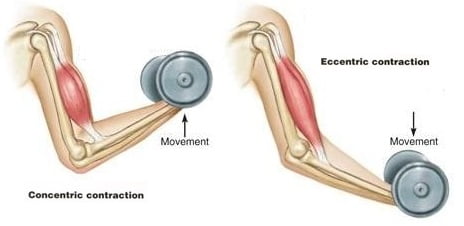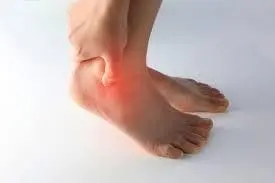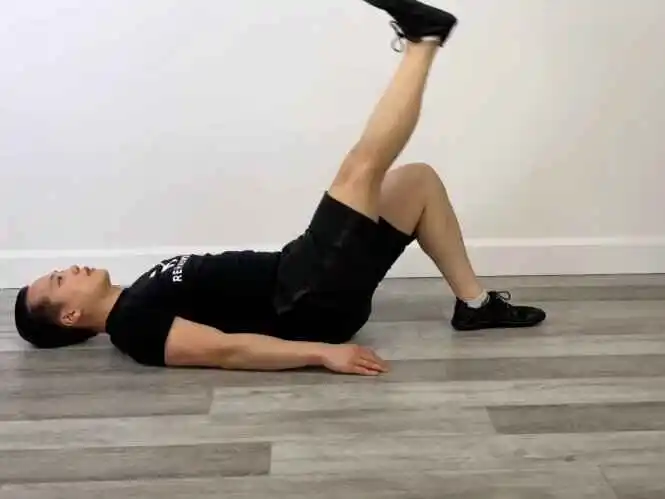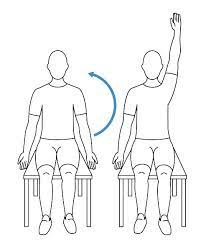12 Best Sciatica Nerve Stretches
Sciatica nerve stretches help relieve pain by reducing tension in the lower back, glutes, and hamstrings. Key stretches include the Piriformis Stretch, Hamstring Stretch with Theraband in Supine, Seated Spinal Twist, Child’s Pose, and Knee-to-Chest Stretch. These stretches promote flexibility, ease nerve compression, and improve mobility.
Introduction:
Sciatica, a disorder marked by pain that travels along the sciatic nerve, usually affects one side of the body. Compression of the nerve, which extends from the lower back to the legs, is frequently the cause.
Sciatica can cause severe, sharp pains, tingling, and numbness, making everyday chores difficult. Fortunately, there are some Sciatica Nerve Stretches that might help reduce sciatica pain by promoting muscle relaxation, increasing flexibility, and reducing nerve compression.
The pain may be minor or so intense that it interferes with sitting, standing, or sleeping. There are several ways to treat sciatica, including stretches that might help reduce the pain.
Causes:
When the sciatic nerve, which passes through the legs and buttocks from the lower back, is compressed, irritated, or inflamed, sciatica pain results. For effective treatment and prevention, it is important that you understand the underlying reasons for the pain, which can range from mild to severe.
Bulging or Herniated Disc (Slipped Disc)
- The vertebrae are cushioned by the spinal discs.
- The sciatic nerve is compressed when a disc bulges or herniates, resulting in pain and irritation.
- This is the most common cause of sciatica, particularly in those between the ages of 30 and 50.
The uncommon cause of sciatica is tumors or growths.
- The sciatic nerve may be compressed by a tumor in the pelvis or spine, resulting in paralysis and pain.
Piriformis Syndrome: Sciatic Nerve Muscle Compression
- The sciatic nerve is compressed when the piriformis muscle, which lies deep in the buttocks, tightens or spasms.
- It frequently results from trauma, overuse, or extended sitting.
Trauma or Injury (Sports Injuries, Falls, or Accidents)
- The sciatic nerve may be affected by edema, disc damage, or muscular tension resulting from a direct injury to the lower back, buttocks, or legs.
Spinal Stenosis (Spinal Canal Narrowing)
- The sciatic nerve is pinched by the narrowing spinal canal.
- This syndrome is common in people over 50 who have bone spurs or arthritis.
Long-Term Sitting (Sedentary Lifestyle)
- Sitting for extended periods weakens the back muscles and puts more strain on the spinal discs, which can compress nerves.
Spondylolisthesis
- A misaligned vertebra presses against the sciatic nerve.
- Stress fractures, age, or birth abnormalities may be the cause of this.
Degenerative Disc Disease
- Vertebrae rub against one another when the spinal discs dehydrate and weakness over time.
- Sciatic pain and nerve compression may result from this.
Signs and symptoms:
Sciatica is characterized by pain in the back that travels down the leg, thigh, and buttocks, usually only affecting one side of the body. A herniated disc, spinal stenosis, or piriformis syndrome are examples of underlying causes that affect the nature and intensity of symptoms.
Burning, shooting, or sharp pain
- The pain extends down one leg from the lower back or buttocks.
- Pain is frequently characterized as burning, electric-like, or acute.
- May get worse when standing, sitting, or moving.
Typical Pain Sites:
- Lower back
- Buttocks
- Back of the thigh
- Back of the calf
- Foot
Having trouble walking or standing
- A leg may “give out” because it is weak.
- Walking, standing up straight, and changing positions can all be challenging when experiencing pain.
- In extreme situations, moving becomes extremely uncomfortable.
Weakness of Muscles
- It could feel weak or be hard to move the affected leg.
- Attempting to stand, move, or climb stairs worsens the symptoms.
- Weakness could be a sign of serious nerve compression that needs immediate medical attention.
One Side of the Body Is Painful
- Although both legs can get affected, sciatica typically affects one leg at a time.
- Which side of the sciatic nerve is squeezed determines which side is affected.
Tingling or numbness
Particularly in the following areas, the affected leg may feel numb or tingly:
- Buttocks
- Thigh
- Calf
- Foot and toes
Can happen independently or in conjunction with pain.
Pain Gets Worse When You Move
- Walking, standing, or sitting for extended periods could worsen pain.
- Sharp pain can be caused by sneezing, coughing, or straining (like carrying heavy objects).
- Depending on where it originates, pain might go away when you lie down or bend forward a little.
Benefits of stretching:
One of the best strategies to control and alleviate sciatica pain is to stretch. Stretching can help relieve pain and stop episodes by increasing circulation, decreasing nerve compression, and improving flexibility. The main advantages of stretching for sciatica pain are as follows:
Reduces Compression in Nerves
- Sciatica is frequently caused by spinal stenosis, tight muscles (piriformis syndrome), or pressure on the sciatic nerve from a herniated disc.
- By opening up the hips and lower back, gentle stretching relieves sciatic nerve pain and compression.
Increases Mobility and Flexibility
- Sciatic pain frequently affects mobility and results in hamstring, hip, and lower back stiffness.
- Frequent stretching increases the range of motion, which helps daily tasks including standing, sitting, and walking.
Stops Sciatica Recurrence in the Future
- Stretching lowers the chance of repeated sciatic pain by maintaining healthy posture and spinal health.
- It fixes any muscle imbalances that can be causing sciatica.
Lessens Pain
- Stretching helps reduce sciatic nerve pain by releasing tense muscles in the legs, buttocks, and lower back.
- It provides long-term pain relief by lowering stress and inflammation.
Builds Up Supporting Muscles
- Over time, sciatica-related pain can cause muscle weakness.
- Stretching helps improve spinal support by activating and strengthening the lower back and core muscles.
Improves Blood Flow and Recovery
- Stretching improves blood flow to the injured area, delivering nutrients and oxygen to calm irritable muscles and nerves.
- Increased circulation may speed up recovery and lessen stiffness.
Promotes relaxation and lessens stress
- Tension and stress in the surrounding muscles can result from sciatica pain.
- Deep breathing and mild exercises help to ease muscle stiffness and relax the body.
Sciatica Nerve Stretches:
The following are some of the best stretches for reducing sciatica pain. Before starting any stretching plan, always get medical advice, especially if you have a previous medical problem.
Knee to Chest Stretch
By gently extending the lower back, glutes, and hamstrings, the Knee-to-Chest Stretch is a quick and easy practice that can help relieve sciatica pain. By reducing the strain on the sciatic nerve, this stretch improves spinal alignment and flexibility.
- Rest on a yoga mat, flat on your back.
- Relax your body and keep your legs outstretched.
- With both hands, bend your right knee and gradually draw it toward your chest.
- Keep your left leg straight out on the ground, or bend it slightly if necessary.
- Make sure that your lower back stays flat on the floor.
- Hold this position for a few seconds.
- Your buttocks and lower back will feel a light stretch.
- Slowly return your right leg to the floor.
- Then return to your neutral position.
- Then relax.
- Repeat this movement 3 to 5 times.
- Keeping your left leg pulled to your chest, repeat the stretch.
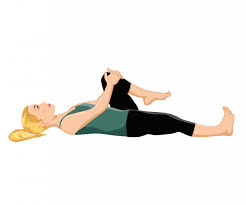
Standing Hamstring Stretch
By relaxing tense hamstrings, lower back muscles, and glutes, the Standing Hamstring Stretch on a Table is a great way to relieve sciatic nerve pain. Maintaining hamstring flexibility helps relieve pain since tight hamstrings may worsen sciatic nerve irritation and cause lumbar strain.
- Place yourself facing a stable table, bench, or other raised surface that is about hip height.
- Keeping your leg straight, place your right foot on the table.
- Keep your left leg grounded and straight.
- As you progressively lean forward from your hips toward your elevated foot, maintain a straight back.
- Focus on bending from the hips rather than rounding your back.
- The hamstrings at the back of your right leg should feel deeply stretched.
- Hold this position for a few seconds.
- Maintain a relaxed posture and a neutral spine.
- Return to a standing position gradually.
- Then relax.
- Repeat this movement 3 to 5 times.
- Lean forward and place the left leg on the table to repeat.
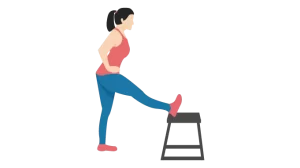
Seated Piriformis Stretch
The piriformis muscle, which is situated deep in the buttocks, is the target of the Seated Piriformis Stretch, a great stretch for sciatica pain relief. Piriformis syndrome is a condition in which the sciatic nerve is compressed by a taut muscle, resulting in pain, tingling, or numbness down the leg.
- Your feet should be flat on the ground when you sit on a comfortable chair.
- Raise your right leg and position your right ankle just above the knee on your left thigh.
- Your right knee should be in the triangle position, pointing outward.
- Maintaining a straight back, slowly bend your upper body forward until your right hip and buttocks start to stretch.
- Hold this position for a few seconds.
- Then return to your neutral position.
- Then relax.
- Repeat this movement 3 to 5 times.
- Repeat with the left leg the same movement.

Supine hamstring stretch
Stretching the hamstrings, lower back, and calves softly is how the Supine Hamstring Stretch with a Strap effectively relieves sciatica pain. Excessive tension on the lower back and sciatic nerve due to tight hamstrings could worsen symptoms.
- Place yourself on a yoga mat, lying on your back.
- Both legs should be relaxed and stretched.
- Keep a towel, yoga strap, or resistance band close at hand.
- Loop the strap around the arch of your right foot while bending your right knee.
- Use both hands to hold the strap’s ends firmly.
- While maintaining a flat left leg on the floor, slowly raise your right leg.
- Pulling your leg gently toward you with the strap will cause your hamstrings to stretch deeply.
- If you have particularly tight hamstrings, keep your knee slightly bent.
- Hold this position for a few seconds.
- Maintain a flat lower back on the mat.
- Then return to your neutral position.
- Then relax.
- Repeat this movement 3 to 5 times.
- On the left leg, repeat the stretch.
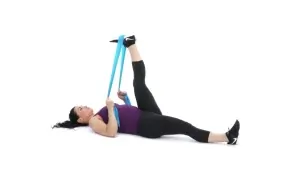
Cat-Cow Stretch
The Cat-Cow Stretch is a mild and efficient practice that improves flexibility, reduces lower back stiffness, and mobilizes the spine to alleviate sciatica pain. It encourages improved posture and spinal alignment while also helping with the relaxation of the sciatic nerve.
- Take a yoga mat and place yourself on your hands and knees.
- Ensure that your wrists are beneath your shoulders and your knees are beneath your hips.
- Your head should be relaxed and your spine should remain neutral.
- After you’ve exhaled, carefully raise your back and tuck your chin into your chest.
- To create a deep stretch in your lower back, pull your belly button toward your spine.
- Hold this position for a few seconds.
- Breathe deeply, then slowly raise your head and tailbone toward the ceiling by extending your back downward.
- As you open your chest, let your stomach fall.
- Hold this position for a few seconds.
- Keep switching slowly and carefully between the Cat Pose and the Cow Pose.
- Then return to your neutral position.
- Then relax.
- Repeat this movement 3 to 5 times.
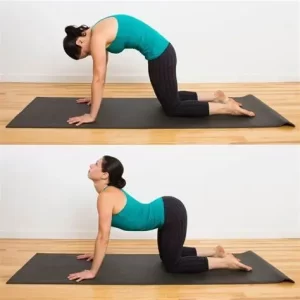
Supine Spine Twist
The Supine Spinal Twist is a very good stretch for sciatica because it loosens tight hip and lower back muscles, improves spinal mobility, and gently decompresses the spine. By reducing the strain on the sciatic nerve, this stretch helps increase flexibility and relieve pain.
- Lay flat on your back on a yoga mat to begin.
- Relax your arms at your sides and straighten your legs.
- Your right knee should be bent and extended up to your chest.
- Gently move your right knee toward the left side of your body.
- Maintain your right shoulder’s grounding on the ground.
- Hold your right arm out to the side, palm up.
- Continue to twist and look toward your right hand.
- Feel your hips, glutes, and lower back stretch deeply.
- Hold this position for a few seconds.
- Then return to your neutral position.
- Then relax.
- Repeat this movement 3 to 5 times.
- On the left side, repeat.
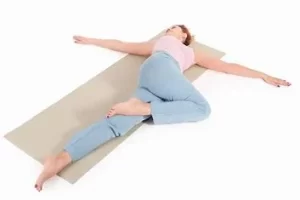
Standing piriformis stretch
Stretching the piriformis muscle, which can compress the sciatic nerve and create pain when it is tight, is a useful method of relieving sciatica pain. In particular, this stretch is helpful if you need relief but don’t have a chair or mat nearby.
- Get up and place your feet hip-width apart.
- Be sure to keep your shoulders relaxed and your spine neutral.
- Place your right ankle just above the knee on your left leg after lifting it.
- A figure-four should be formed by your right knee pointing outward.
- Lower your body to the level of a chair by slowly bending your left knee.
- As you balance, keep your back straight and your chest raised.
- It should cause your right hip and glute to stretch deeply.
- Hold this position for a few seconds.
- For balance, utilize a wall or chair if required.
- Get back up slowly and change legs.
- Then return to your neutral position.
- Then relax.
- Repeat this movement 3 to 5 times.
- On the left side, repeat the stretch by resting your left ankle on your right thigh.
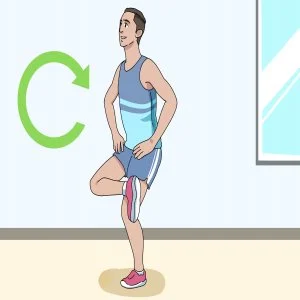
Hip Flexor Stretch
Sciatica pain can be alleviated by stretching the hip flexors, particularly if tight hip flexors are causing nerve compression and pelvic misalignment.
- Place your left foot forward and your right knee on the floor to begin in a lunge position (the knee should be at a 90-degree angle).
- Maintain a straight spine by using your core.
- To increase the depth of the stretch, gently tilt your pelvis backward, also known as posterior pelvic tilt.
- To feel a stretch in the front of your right hip, move your weight forward a little.
- Hold this position for a few seconds.
- Then return to your neutral position.
- Then relax.
- Repeat this movement 3 to 5 times.
- Repeat on the opposite leg.
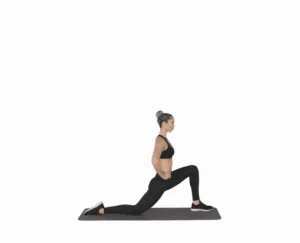
Child’s Pose
Child’s Pose (Balasana) is a mild yoga pose that stretches the thighs, hips, glutes, and lower back to assist relieve sciatica pain. By encouraging spinal decompression, it may lessen the strain on the sciatic nerve.
- Begin on your hands and knees, tabletop, or on a cushioned surface, such as a yoga mat.
- Sitting your hips back into your heels, pull your big toes together.
- Place your forehead on the mat and extend your arms forward.
- Feel your lower back and glutes gently stretch as you take a deep breath.
- Hold this position for a few seconds.
- Then return to your neutral position.
- Then relax.
- Repeat this movement 3 to 5 times.
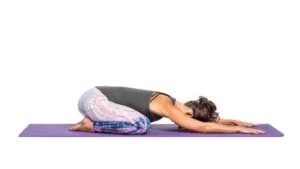
Pigeon pose
This yoga pose, which stretches the piriformis, glutes, and hip flexors deeply, is a great way to relieve sciatica pain. The sciatic nerve can be compressed by a taut piriformis muscle, so this pose helps reduce tension and increase flexibility, which lessens pain and suffering.
- Start by putting yourself on your hands and knees on a yoga mat in a tabletop pose.
- Maintain knees beneath hips and wrists beneath shoulders.
- Move your right knee in the direction of your right wrist.
- Place your right foot near your left hip (closer for beginners, further for a more thorough stretch).
- Straighten your left leg behind you while maintaining a square hip position.
- Maintain a calm and pointed left foot.
- Maintain your hands on the mat for balance, or
- Lower your forehead or forearms to the mat for a more thorough stretch.
- Relax into the stretch and take a big breath.
- Hold this position for a few seconds.
- Your lower back, glutes, and hips should all feel deeply stretched.
- Return to the tabletop posture gradually.
- Then return to your neutral position.
- Then relax.
- Repeat this movement 3 to 5 times.
- Continue on the left side, extending your right leg back and putting your left knee forward.

Cobra Stretch
The Cobra Stretch is an excellent workout for sciatica pain because it relaxes the spine, eases the strain on the sciatic nerve, and gently extends the lower back. It is especially helpful for sciatica caused by a misaligned spine or a bulging disc.
- Place yourself on a yoga mat, flat on your stomach.
- Make sure your feet are flat on the ground and your legs are straight out in front of you.
- With your elbows bent and your palms flat on the mat, place your hands beneath your shoulders.
- With your palms pressed down, slowly raise your shoulders and body off the ground.
- Legs and hips should remain loose on the mat.
- Maintaining an upright posture and keeping your shoulders away from your ears, contract your lower back muscles.
- Hold this position for a few seconds.
- Feel the muscles in your abdomen and lower back gently stretch.
- Return your chest to the floor slowly while maintaining control.
- Then return to your neutral position.
- Then relax.
- Repeat this movement 3 to 5 times.

Glute Bridge
By stretching the hip flexors and strengthening the glutes, lower back, and core, the Glute Bridge Stretch is a great way to prevent and cure sciatica pain. It also lessens pressure on the sciatic nerve and helps stabilize the spine.
- On a yoga mat, lie flat on your back.
- Maintaining your feet flat on the floor (hip-width apart), bend your knees.
- Put your arms at your sides and rest your hands down.
- To raise your hips toward the ceiling, squeeze your glutes and push through your heels.
- As you raise your lower body, keep your shoulders and upper back on the floor.
- From knees to shoulders, your body should be in a straight line.
- Hold this position for a few seconds.
- Keeping your glutes active Breathe slowly and deeply.
- Maintaining control, gently lower your hips back to the floor.
- Then return to your neutral position.
- Then relax.
- Repeat this movement 3 to 5 times.
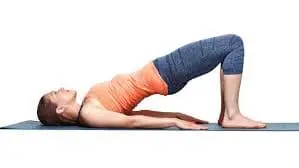
What precautions should be taken when stretching?
Stretching for sciatica pain requires careful consideration to prevent worsening the issue or injuring more people. The sciatic nerve travels from the lower back through the hips, buttocks, and down each leg. Irritation or compression of this nerve causes sciatica. Although incorrect technique or overexertion might exacerbate soreness, stretching can help reduce it.
Before stretching, warm up.
- Warm up your muscles with simple exercises like walking or mild pelvic tilts before stretching.
- Stretching becomes safe as a result of the increased blood flow and decreased stiffness.
Stretching and Strengthening Together
- Over time, sciatic pain can be lessened and the spine supported by strengthening the lower back, glutes, and core muscles.
- Chronic pain may be avoided with exercises like planks, bird dogs, and bridges.
Evenly stretch both sides.
- Stretching both legs, even if just one side is hurting, maintains muscular balance and avoids imbalances that could make the issue worse.
Do not overstretch or jump.
- Never force yourself into pain; instead, stretch slowly and gently.
- Stretching should not involve jumping or jerking since this might cause nerve and muscle strain.
If support is required, use it.
- If you find it uncomfortable to stretch on the floor, consider using cushions, yoga blocks, or a chair.
- This may decrease lower back tension and make stretches more accessible.
Keep Your Posture and Form Correct
- Stretches should be performed with proper posture to avoid putting too much strain on the sciatic nerve.
- To support your lower spine, maintain a straight back and a strong core.
Don’t overdo it, but remain consistent.
- Stretch frequently, but don’t stretch too much at once.
- Stretching for 15 to 30 seconds two to three times a day is a lot.
Concentrate on Slow, Gentle Motions
- Avoid sudden motions that can cause the sciatic nerve to shock.
- Instead of hurrying, take your time going in and out of stretches.
- Take a deep breath and relax.
Take a deep breath and relax
- Stretching during deep breathing reduces stress and increases the range of motion.
- Stiffness from holding your breath reduces the effectiveness of stretches.
Do Not Stretch Cold Muscles
- Before stretching, try some light mobility exercises if you’re stiff in the morning.
- Cold muscles are more likely to stretch and get hurt.
Be Aware of Pain Signals
- Sharp, stabbing, or rising pain is an indication that something is wrong, but mild pain is normal.
- Stop a stretch right away if it results in numbness, tingling, or worsened leg pain.
- Adjust stretches according to your comfort level.
Adjust stretches according to your comfort level.
- Try a less painful version of the stretch or adjust it if it hurts too much.
Consider Professional Advice If Symptoms Get Worse
- Consult a doctor, or physical therapist if stretching doesn’t help with your pain or if it gets worse.
- Based on your unique situation, they can suggest safe, personalized exercises.
At what point should you stop stretching?
Sciatica pain can be effectively relieved by stretching, but if you keep stretching when your body tells you it’s uncomfortable, it can get worse. To prevent additional pain, inflammation, or nerve damage, it’s important to know when to quit.
The warning symptoms listed below are clear indicators that you should to stop stretching and get help.
- Pain in the lower back, buttocks, or down the leg that is acute, stabbing, or burning.
- After stretching, the pain travels farther down the leg.
- Nerve pain that is new or worse than it was previously.
Stretching should reduce stress rather than make it worse. You might be overstretching, compressing the nerve, or doing the incorrect kind of stretch for your condition if your symptoms get worse.
If You Feel Pain in a New Area
- Stretching was supposed to help with one region of pain, but now it’s hurting in another.
- You get pain in the opposite leg, neck, or upper back.
- A stretch makes a previous injury or another area of your spine worse.
One side is typically affected by sciatica. You can be compensating with improper motions if you experience new pain in unexpected places.
If You Experience Dizziness or Lightheadedness
- Lightheadedness, nausea, or dizziness during stretching.
- Vision problems or feeling faint.
Holding your breath when stretching, poor circulation, or variations in blood pressure can all cause this.
If After Stretching, Pain Continues for More Than a Few Minutes
- After stretching, the pain continues for more than half an hour.
- After stretching, you experience soreness for several hours or the following day.
While some pain is typical, ongoing pain may indicate sciatic nerve irritation or overstretching.
If You Experience Weakness, Numbness, or Tingling
- Numbness in the legs, foot, buttocks, or lower back.
- After stretching, tingling occurs.
- Weakness in the legs or feet, trouble standing, or muscle failure.
Weakness, tingling, or numbness indicate that the sciatic nerve is not being relaxed but rather restricted or inflamed. Stretching further could harm the nerve even more.
If a pop or tear is heard or felt
- The hamstrings or lower back make a popping or cracking noise.
- A feeling of tearing in the legs, hips, or back.
- Sudden immobility following the experience.
These symptoms point to spine problems, ligament injury, or strained muscles. If you push through, you might get seriously hurt and need a long time to recover.
If the Symptoms of Sciatica Get Worse Over Time
- Despite stretching frequently, sciatica pain is more common or more severe.
- You start having trouble standing, sitting, or walking comfortably.
- Inability to control one’s bowels or bladder (get emergency care immediately).
These symptoms point to a worsening problem, which could be caused by significant nerve compression or a herniated disc. Stretching by itself might not be enough.
How can sciatica pain be prevented?
Maintaining a healthy spine, strong muscles, and suitable movement patterns to lessen the strain on the sciatic nerve are all important ways to prevent sciatica pain.
By taking these precautions, you can reduce your chance of getting sciatica or having it get worse.
Engage in Regular Exercise
Frequent exercise improves spinal support and lessens the pressure on the sciatic nerve by strengthening the leg, back, and core muscles.
Best Exercises to Prevent Sciatica:
Best Exercises to Prevent Sciatica:
- Walking, swimming, and cycling are examples of low-impact activities.
- Flexibility & Stretching Exercises (Pilates, Yoga)
Utilize Safe Lifting Methods
Improperly lifting large objects might increase the risk of sciatica by causing disc damage and straining the lower back.
Tips for Safe Lifting:
- Lift using your legs, not your back. Squat down and maintain a straight back.
- Keep Items Near Your Body: When lifting, refrain from reaching or twisting.
- Avoid Sudden Movements: To avoid straining your muscles, move gently and gradually.
Keep a Healthy Weight
Being overweight increases the risk of ruptured discs and nerve compression by putting additional strain on the lower back and spine.
How to Keep Your Weight in Check:
- Consume a well-balanced diet high in lean meats, fiber, and good fats.
- Refrain from eating too much sugar and processed meals, which can cause weight gain.
- Engage in regular physical activity, such as swimming, yoga, or walking.
Keep Your Posture Correct
Bad posture increases the risk of nerve compression and sciatica pain by placing excessive stress on the spine.
When seated:
- Maintain a straight back and relaxed shoulders.
- Behind your lower back, place a rolled towel or a lumbar support cushion.
- Keep your legs flat on the ground and don’t cross them.
- Every 30 to 60 minutes, take a quick take break to stand and stretch.
While standing:
- Equally, divide your weight between your two feet.
- Make sure your head and spine are in position.
- Move your weight frequently to avoid standing still for extended periods.
While you’re sleeping:
- To lessen the tension on your spine, sleep on your side with a pillow between your knees.
- Put a cushion beneath your legs for support if you sleep on your back.
Stay away from uncomfortable shoes and high heels.
Poorly supported shoes and high heels change the posture of the spine and put more strain on the lower back.
Suggestions for Shoes:
- Select shoes using suitable arch support and low heels.
- If you have arch issues or flat feet, use orthotic inserts.
- When walking daily, use supportive sandals or sneakers with cushions.
Avoid Extended Sitting
Long-term sitting puts more strain on the sciatic nerve and lumbar spine, which causes pain and stiffness.
How to Spend Less Time Sitting:
- Stretch and get up every 30 to 60 minutes. Make use of a lower-back-supporting ergonomic chair.
- Try switching between sitting and standing, or try a standing desk.
- Move about when on the phone or in meetings.
Make Time to Stretch
- Stretching keeps the legs, hips, and lower back flexible, avoiding stiffness and compression of the nerves.
Consume anti-inflammatory foods and stay hydrated.
A balanced diet and sufficient water intake maintain the hydration of the spinal discs and lessen inflammation surrounding the sciatic nerve.
Top Foods That Reduce Inflammation:
- Vegetables and Fruits (kale, spinach, berries)
- Nuts, avocados, and olive oil are healthy fats.
- Omega-3s: walnuts, flaxseeds, and salmon
- Ginger and turmeric (natural anti-inflammatory properties)
Build up your back and core muscles.
In order to minimize sciatic nerve compression, a strong core stabilizes the spine and lessens strain on the lower back.
Top Core Workouts:
- The entire core is strengthened by planks.
- Bird-Dog Exercise: Improves spinal stability.
To strengthen your spine, perform core exercises three to four times a week.
Handle Mental Health and Stress
Stress may worsen sciatica symptoms by causing lower back muscular stress.
Strategies for Reducing Stress:
- Exercises including deep breathing can help release tense muscles.
- Yoga and meditation help to increase spinal flexibility and reduce stress.
- Frequent massage therapy helps to relieve lower back muscle stiffness.
Summary:
The longest nerve in the body, the sciatic nerve, can become inflamed or compressed, leading to sciatica. This nerve runs down each leg from the lumbar back via the hips and buttocks. From minor pain to severe, painful pain that interferes with everyday tasks like walking, sitting, or standing for extended periods of time, sciatica pain can vary widely. Muscle weakness, tingling, or numbness may accompany the pain, which frequently travels down one leg.
You may greatly manage and lessen sciatica pain by including these stretches in your everyday routine. To prevent more injuries, consistency is essential, as is using the right form. The effectiveness of these exercises can be increased by combining them with proper posture, frequent physical activity, and ergonomic workstation modifications.
For secure and effective stretching, make sure you do them frequently and pay attention to your body.
FAQ:
What is the pain associated with sciatica?
The sciatic nerve travels from the lower back into the legs and buttocks, and sciatica pain is caused by irritation, inflammation, or compression of this nerve. One leg usually experiences acute, burning, or radiating pain.
What are the most common causes of sciatica?
Most frequently, a herniated or slipped disc.
Spinal stenosis, or spinal canal narrowing.
The sciatic nerve is compressed by the tense piriformis muscle in piriformis syndrome.
Degenerative disc disease.
Spondylolisthesis.
Injury or imbalances in the muscles.
Which symptoms are associated with sciatica?
Legs, buttocks, and lower back pain that is sudden and intense.
Affected limb numbness, tingling, or weakness.
Pain that gets worse when you walk, stand, or sit.
What is the duration of sciatica pain?
Acute sciatica may last anywhere from a few days to several weeks.
Chronic sciatica: May need long-term care if it continues for more than three months.
Can a sciatica injury heal itself?
Yes, relaxation, light movement, and stretching can help relieve mild cases of sciatica on their own. However, medical help is required if the pain intensifies, lasts longer than a few weeks, or causes numbness or weakness.
Which sleeping posture is ideal for those with sciatica?
Having a cushion between your knees when lying on your side
Using a cushion beneath your knees while lying on your back
Avoid sleeping on your stomach since it causes strain in your spine.
Which stretches are most effective for relieving sciatica?
Piriformis stretch
Knee-to-chest stretch
Hamstring stretch
Cat-Cow stretch
Cobra pose
Which activities should you refrain from if you have sciatica?
Extended periods of standing or sitting
Poor posture and heavy lifting
Exercises with a lot of impact (running, jumping)
Excessive forward twisting or bending
Can sciatica be relieved by walking?
Walking does increase circulation and lower nerve pressure but stay away from excessive steps and bad posture. It helps to walk mindfully and slowly while wearing suitable shoes.
Is it possible to prevent sciatica?
Indeed! Keeping proper posture both when standing and when sitting are two strategies to avoid sciatica.
Regular exercise with a concentration on back and core strength
Lifting correctly means bending your knees, not your back.
Preventing extended periods of sitting
Which is better for sciatica: heat or ice?
For the first 48 hours, ice helps to minimize inflammation.
After 48 hours, heat helps to increase circulation and relax tense muscles.
How frequently should I stretch my sciatic nerve?
For best effects, stretch at least once or twice a day.
Repeat two or three times, holding each stretch for 15 to 30 seconds.
Keep in mind that overstretching may increase pain.
Does stretching increase sciatica pain?
Yes, if done incorrect or forcefully. Give up stretching if you experience:
A sharp or shooting pain
An increase in tingling or numbness
Weakness in the legs
Do I need to avoid any stretches since I have sciatica?
Deep forward bends or touching your toes (if you have a herniated disk)
Poor posture during seated hamstring stretches might irritate the sciatic nerve.
Jerking or twisting motions
Can sciatica be relieved by yoga?
Indeed! Mild yoga relieves tension in the nerves and increases flexibility. Such as the Child’s Pose, Cat-Cow Pose, and Pigeon Pose
The Cobra Pose
Should I stretch my sciatic nerves before or after working out?
Before working out, warm up with light mobility exercises.
Stretch deeper to release tense muscles after working out.
References:
- Heitz, D. February 2, 2024. Nine stretches to relieve sciatica pain. Healthline. Stretches for sciatica https://www.healthline.com/health/back-pain
- B. J. P. D. O. Cscs (n.d.). Sciatica Pain Relief Stretches & Exercises from a PT. Hospital for Special Surgery. The article “Sciatica Stretches” can be found at https://www.hss.edu.
- Fletcher, J. August 28, 2024. Eight stretches to relieve sciatica pain. Articles/317920, https://www.medicalnewstoday.com
- SportsMed, Y. (October 7, 2022). Toronto physiotherapists | Yorkville Sports Medicine Clinic | Top 5 sciatic nerve stretches to relieve nerve discomfort. Physiotherapy services are provided in Toronto by Yorkville Sports Medicine Clinic. The following website offers the top 5 sciatic nerve stretches for sciatic pain relief: https://www.yorkvillesportsmed.com/blog/
- Restivo, J. January 13, 2025. Sciatica: Mild stretches to increase range of motion and reduce pain. Harvard Health. Pain/Sciatica-gentle-stretches-to-help-relieve-pain-and-improve-mobility https://www.health.harvard.edu
- Nysi. January 7, 2025. Stretches for sciatica that you can perform in bed. NYSI. https://www.nyspine.com/blog/sciatica-stretches-that-can-be-performed-in-bed/
- Sciatica-relieving stretches | Advanced Spine Care blog, n.d. NJ’s Leading Spine Relief Physicians at The Advanced Spine Center. Sciatica pain relief: https://theadvancedspinecenter.com/
- Sciatica. March 19, 2025. Cleveland Medical Center. Sciatica https://my.clevelandclinic.org/health/diseases/12792-


